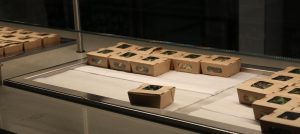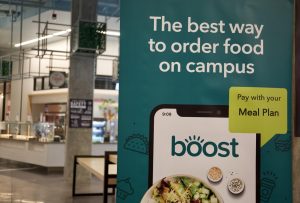Kincart: Stop Ripping Off Students with Meal Plans
Boost pick up station at the Kahlert Village Dining on the University of Utah campus in Salt Lake City on September 13th 2020. (Photo by Camille Rousculp | The Daily Utah Chronicle)
September 18, 2020
College dining halls are doing things differently this year in order to prevent the spread of COVID-19. At the University of Utah, dining halls on campus are only offering takeout as an option.
During any other given year, I imagine that dining halls at the University of Utah would allow students to dine in or at least eat off of a real plate. Students would tap their uCard, grab a tray, fill their tray with multiple plates of food from different areas of the dining hall, eat at a table nearby and take their tray and plates to the washing area. Because of COVID-19, this process has severely changed.

When students go to the dining halls, they are given a bag to fill with boxes of food from the counters. To encourage social distancing, the University of Utah has contracted the Boost Mobile app, an online ordering service for grab and go dining. Students are able to order their meals ahead of time on the app and walk in to pick them up without spending time in a crowded dining hall. However, I’ve noticed that Boost limits the amount of food students are able to get with their meal plan. This limitation means that the university’s attempt to incentivize social distancing practices — by encouraging take-out through Boost — actually incentivizes the opposite because it limits food so drastically.
To understand Boost’s flaws, we have to understand how the meal system works at the University of Utah. Meal taps are the most common way students access food on campus. One tap allows you to get as much food as you want while in the dining hall. Taps are available at Kahlert Village and the Peterson Heritage Center Dining Room and both include options to accommodate food allergies.
Personally, living on campus made the most sense for me. As a freshman, my on-campus living options did not include a kitchen — which meant that I was required to purchase a meal plan. Everyone has to eat, so living on campus without a personal kitchen makes strict enforcement of social distancing difficult. My choices include cooking in a community kitchen available to my whole floor or going to the dining hall. Although both options pose a risk to my health amidst a pandemic, going to a dining hall seems to be the most convenient choice. Because I want to stay safe during the pandemic, I have attempted to use Boost to help practice social distancing.

Like many students, at the beginning of the semester, I downloaded the Boost app on my phone, created an account and entered my ID number to synch my meal plan. In theory, this app could offer a user-friendly way to social distance. In reality, it’s incredibly limiting. One tap on the app only lets us add up to $9.50 in our carts — a seemingly arbitrary number since meal transfers are only worth $5.50 at breakfast and $7.50 at lunch and dinner. Not only does this point to a flaw in the app, but it also speaks to the larger issue of the university not understanding what an investment meal plans are for students.
The problem with Boost is that there is a discrepancy between how the app accommodates meal plans and how in-person transactions work. Because students are unable to order more food for one meal on the app, many students eat in-person at the dining halls. Meal plans are an investment students will want to make the most of their money. The University of Utah is enforcing capacities in the dining halls and making all food carry out, but it isn’t enough because of all the risks associated with dining.
Expansive pick-up options are the common sense solution to prioritizing students’ health. University dining has put students in an unfair situation. Students shouldn’t have to compromise their health to make sure they get their money’s worth. The University of Utah should find another way to make dining halls more social distancing friendly and Boost needs to adapt to become more compatible with the U’s dining hall system.








